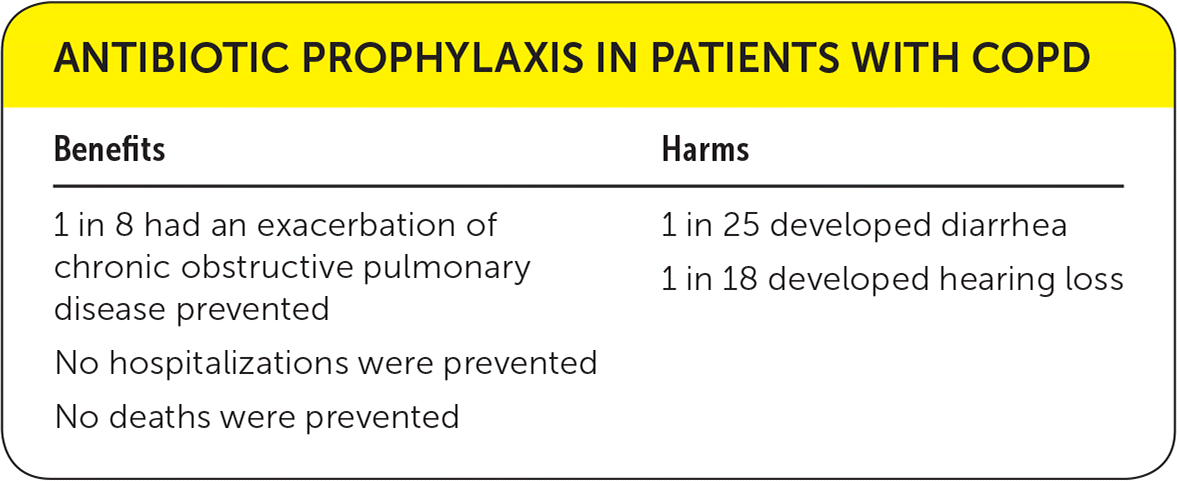
Am Fam Physician. 2019;99(11):online
Author disclosure: No relevant financial affiliations.

Details for This Review
Study Population: Patients older than 40 years with spirometry-proven diagnosis of moderate to severe chronic obstructive pulmonary disease (COPD)
Efficacy End Points: COPD exacerbations, frequency of exacerbations, time to first exacerbation, and health-related quality of life as measured by the St. George's Respiratory Questionnaire or the Chronic Respiratory Diseases Questionnaire
Harm End Points: Drug resistance as measured by microbial sensitivity, adverse drug effects, hospitalization, and all-cause mortality
Narrative: COPD is defined as persistent respiratory symptoms and airflow obstruction caused by alveolar and airway dysfunction resulting from exposure to noxious particles and gases.1 It is common throughout the world and is the third leading cause of death in the United States.2 Morbidity from COPD is costly, reducing the capacity for work3 and increasing the number of emergency department visits and hospitalizations.4 It can profoundly reduce quality of life, causing social isolation and depression.5,6 Viral infections account for most exacerbations, but bacterial colonization increases with the severity of COPD, and bacterial infections are more common in acute exacerbations.7
In theory, antibiotics provide their benefit by decreasing bacterial growth, potentially limiting the inflammatory effects of the bacteria.8,9 Prophylactic antibiotics were routinely administered for cases of chronic bronchitis 30 years ago, but this practice declined amid concern for antibiotic resistance without evidence of efficacy.
The Cochrane group identified 14 randomized controlled trials of antibiotics compared with placebo, with end points of prevention of COPD exacerbations or improved quality of life. The studies were published or presented between 2001 and 2017 and included a total of 3,932 participants. Nine trials studied continuous macrolide antibiotic treatment (1,925 participants); two examined antibiotics administered three times weekly (176 participants); two studied pulsed antibiotics given three days per month or five days every eight weeks (1,732 participants), and one trial compared three arms: continuous doxycycline vs. azithromycin (Zithromax) administered three times weekly vs. moxifloxacin (Avelox) for five days every month (99 participants). The heterogeneity of the studies was moderate.

| Benefits | Harms |
|---|---|
| 1 in 8 had an exacerbation of chronic obstructive pulmonary disease prevented | 1 in 25 developed diarrhea |
| No hospitalizations were prevented | 1 in 18 developed hearing loss |
| No deaths were prevented |
The number needed to treat to prevent one exacerbation of COPD was 8. The effect was evident only when patients received antibiotics at least three times weekly. There was no significant impact on the frequency of hospitalization, all-cause mortality, or quality of life.
Data reporting for adverse drug events and microbial resistance was inadequate for a formal meta-analysis. A single study demonstrated a number needed to harm of 25 to cause one case of diarrhea and 18 to cause a single case of hearing loss. Single-study analyses of microbial resistance demonstrated a risk of rapid resistance to moxifloxacin in patients colonized with Pseudomonas. All but two studies, both of shorter duration (six months or less), demonstrated an increase in the minimum inhibitory concentration of bacteria cultured from sputum of patients exposed to prophylactic antibiotics.
Caveats: Optimization of preventive regimens, including long-acting muscarinic antagonists, long-acting beta agonists, inhaled corticosteroids, phosphodiesterase-4 inhibitors, and mucolytics, was not reported and potentially limited the validity of these results. In an attempt to control for this source of bias, the authors examined studies published from 2005 to 2009, 2010 to 2014, and 2015 onward. Despite improvements in medical management of COPD over this period, the authors found no change in the effectiveness of antibiotic prophylaxis when examining earlier vs. later studies.
In addition, three studies were not double-blinded, eight did not clearly blind the outcome assessment, four were subject to attrition bias, one had selective reporting, and another was at unclear risk because no prospective trial registration or protocol could be evaluated. When the authors performed a sensitivity analysis, removing all trials at high risk of bias, the results were similar to the primary analysis.
This research fails to determine whether the modest potential benefits of prophylaxis outweigh the risk of resistance. Antibiotic prophylaxis is proposed to work by decreasing bacterial colonization, but slow-multiplying bacteria, such as those found in biofilms, are profoundly tolerant to antibiotics.10 Lengthy, multidrug regimens are required to kill these bacteria. Single-agent coverage may temporarily target rapidly multiplying bacteria and halt exacerbations, but lengthy courses with single agents may lead to resistance. Longer-term studies might uncover an increased cost and mortality for treating pneumonia in patients with COPD in which resistance has been worsened by ineffective chronic suppressive therapy.
